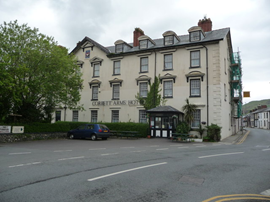UNESCO World Heritage Status tentative list
The new Tentative List, the UK government’s latest attempt to add to UNESCO’s list of world heritage sites, now has seven sites from across the UK and Overseas Territories. Most, if not all of them, will never make it to UNESCO’s list, but the government, local authorities and devolved administrations will now work hard to develop their bids.
‘Site’ in the phrase ‘world heritage site’ is defined rather broadly, as the UK’s tentative seven show. The first two on the list are distinct places. ‘Birkenhead the People’s Park’ as the list describes it, is the pioneering municipal park. It opened in 1847, across the River Mersey from Liverpool, which no longer has a world heritage site. Next comes York, which the government announcement breathlessly tells us has ‘fantastic civic and religious buildings including its Minster as well as a rich history left behind by its Anglo-Saxon, Viking and Norman inhabitants’.
‘The Zenith of Iron Age Shetland’ is a collection of three ancient settlements, one on the island of Mousa, the other two on the Shetland mainland, all three including the remains of round towers known as brochs. The proposed site of ‘Gracehill Moravian Church Settlement in Northern Ireland’ is part of a joint bid alongside other Moravian religious sites in Denmark, the USA and Germany, celebrating that religious community.
The other three ‘sites’ on the tentative list are what are classified as ‘natural’ rather than ‘cultural’. ‘East Atlantic Flyway: England East Coast Wetlands’ is not so much a place as a migratory bird route over western parts of Europe, including parts of Yorkshire, Lincolnshire, Norfolk, Suffolk, Essex and Kent. ‘The Flow Country’ is a vast expanse of blanket bog (a rare type of peatland) in the north of Scotland. Apparently it is more fun than it sounds. According to the Flow Country website, you can become a volunteer, staying ‘for a few weeks or a few months – some folk end up staying for years’.
Finally, the ‘Little Cayman Marine Parks and Protected Areas’, situated in the UK Overseas Territory of the Cayman Islands, have been put forward, not for their contribution to dodgy banking, but for ‘their exceptional importance to marine biodiversity and their incredible natural beauty’.
The ancient world, keeping it simple, celebrated Seven Wonders. UNESCO has more than 1,000 on its list of ‘sites of outstanding universal value’. The task of selecting even that number from what must surely be potentially tens of thousands of places of such value is inevitably often the cause of furious debate. UNESCO defines outstanding universal value as ‘cultural and/or natural significance which is so exceptional as to transcend national boundaries and to be of common importance for present and future generations of all humanity’.
Those of us who have not been landed with the almost impossible job of applying that definition can enjoy the fruits of the process that highlights some of the very best of what the world has to offer.
The article is an extract from the Context Journal and appears on the IHBC news and blog site as "New Context out, on World Heritage Sites, designation, Armageddon and even more" dated July 03, 2023.
--Institute of Historic Building Conservation
[edit] Related articles of Designing Buildings
- World heritage site.
- Conservation area.
- Conservation in the heritage cities of Venice and Liverpool.
- Delisting Liverpool world heritage site.
- Designated areas.
- Edinburgh world heritage site valued at over 1 billion.
- Heritage definition.
- International heritage policy.
- Landscapes of human exploitation.
- Listed building.
- Outstanding universal value.
- Saltaire.
- Scheduled monuments.
- Site of Nature Conservation Interest (SNCI).
- Sites of special scientific interest SSSI.
- Special areas of conservation.
- Special protection areas.
- Stonehenge tunnel.
- Urban Heritage, Development and Sustainability.
[edit] External links
IHBC NewsBlog
Images from inside a Grade II listed hotel show the scale of its collapse
The Corbett Arms in Tywyn has fallen into serious disrepair.
Old Sarum fire in listed (& disputed) WW1 Hangar - Wiltshire Council has sought legal advice after fire engulfed a listed First World War hangar that was embroiled in a lengthy planning dispute.
UK Antarctic Heritage Trust launches ‘Virtual Visit’ website area
The Trust calls on people to 'Immerse yourself in our heritage – Making Antarctica Accessible'
Southend Council pledge to force Kursaal owners to maintain building
The Council has pledged to use ‘every tool in the toolbox’ if urgent repairs are not carried out.
HE’s Research Magazine publishes a major study of the heritage of England’s suburbs
The article traces the long evolution of an internal programme to research 200 years of suburban growth
IHBC Context 183 Wellbeing and Heritage published
The issue explores issues at the intersection of heritage and wellbeing.
SAVE celebrates 50 years of campaigning 1975-2025
SAVE Britain’s Heritage has announced events across the country to celebrate bringing new life to remarkable buildings.
IHBC Annual School 2025 - Shrewsbury 12-14 June
Themed Heritage in Context – Value: Plan: Change, join in-person or online.
200th Anniversary Celebration of the Modern Railway Planned
The Stockton & Darlington Railway opened on September 27, 1825.
Competence Framework Launched for Sustainability in the Built Environment
The Construction Industry Council (CIC) and the Edge have jointly published the framework.














